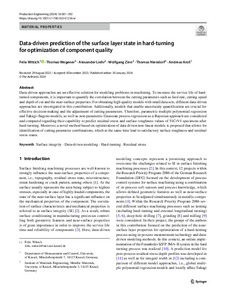Data‑driven prediction of the surface layer state in hard‑turning for optimization of component quality
| dc.date.accessioned | 2024-04-12T11:06:22Z | |
| dc.date.available | 2024-04-12T11:06:22Z | |
| dc.date.issued | 2024-01-30 | |
| dc.identifier | doi:10.17170/kobra-202404109952 | |
| dc.identifier.uri | http://hdl.handle.net/123456789/15656 | |
| dc.description.sponsorship | Gefördert im Rahmen des Projekts DEAL | |
| dc.language.iso | eng | |
| dc.rights | Namensnennung 4.0 International | * |
| dc.rights.uri | http://creativecommons.org/licenses/by/4.0/ | * |
| dc.subject | Surface integrity | eng |
| dc.subject | Data-driven modeling | eng |
| dc.subject | Hard-turning | eng |
| dc.subject | Residual stress | eng |
| dc.subject.ddc | 620 | |
| dc.title | Data‑driven prediction of the surface layer state in hard‑turning for optimization of component quality | eng |
| dc.type | Aufsatz | |
| dcterms.abstract | Data-driven approaches are an effective solution for modeling problems in machining. To increase the service life of hardturned components, it is important to quantify the correlation between the cutting parameters such as feed rate, cutting speed and depth of cut and the near-surface properties. For obtaining high-quality models with small data sets, different data-driven approaches are investigated in this contribution. Additionally, models that enable uncertainty quantification are crucial for effective decision-making and the adjustment of cutting parameters. Therefore, parametric multiple polynomial regression and Takagi–Sugeno models, as well as non-parametric Gaussian process regression as a Bayesian approach are considered and compared regarding their capability to predict residual stress and surface roughness values of 51CrV4 specimens after hard-turning. Moreover, a novel method based on optimization of data driven non-linear models is proposed that allows for identification of cutting parameter combinations, which at the same time lead to satisfactory surface roughness and residual stress states. | eng |
| dcterms.accessRights | open access | |
| dcterms.creator | Wittich, Felix | |
| dcterms.creator | Wegener, Thomas | |
| dcterms.creator | Liehr, Alexander | |
| dcterms.creator | Zinn, Wolfgang | |
| dcterms.creator | Niendorf, Thomas | |
| dcterms.creator | Kroll, Andreas | |
| dc.relation.doi | doi:10.1007/s11740-023-01256-w | |
| dc.subject.swd | Oberfläche | ger |
| dc.subject.swd | Modellierung | ger |
| dc.subject.swd | Integrität | ger |
| dc.subject.swd | Stress | ger |
| dc.type.version | publishedVersion | |
| dcterms.source.identifier | eissn:1863-7353 | |
| dcterms.source.issue | Issue 2 | |
| dcterms.source.journal | Production Engineering | eng |
| dcterms.source.pageinfo | 381 - 392 | |
| dcterms.source.volume | Volume 18 | |
| kup.iskup | false |
Dateien zu dieser Ressource
Das Dokument erscheint in:
-
Artikel [1109]


